Check answers here:
Chapters 15 – 17: Conditional Forwarding and Route Redistribution Exam Answers
Quiz-summary
0 of 32 questions completed
Questions:
- 1
- 2
- 3
- 4
- 5
- 6
- 7
- 8
- 9
- 10
- 11
- 12
- 13
- 14
- 15
- 16
- 17
- 18
- 19
- 20
- 21
- 22
- 23
- 24
- 25
- 26
- 27
- 28
- 29
- 30
- 31
- 32
Information
CCNP ENARSI v8 Chapters 15 – 17: Conditional Forwarding and Route Redistribution Test Online
You have already completed the quiz before. Hence you can not start it again.
Quiz is loading...
You must sign in or sign up to start the quiz.
You have to finish following quiz, to start this quiz:
Results
0 of 32 questions answered correctly
Your time:
Time has elapsed
You have reached 0 of 0 points, (0)
| Average score |
|
| Your score |
|
Categories
- Not categorized 0%
- 1
- 2
- 3
- 4
- 5
- 6
- 7
- 8
- 9
- 10
- 11
- 12
- 13
- 14
- 15
- 16
- 17
- 18
- 19
- 20
- 21
- 22
- 23
- 24
- 25
- 26
- 27
- 28
- 29
- 30
- 31
- 32
- Answered
- Review
-
Question 1 of 32
1. Question
1 pointsWhich three statements describe ACL processing of packets? (Choose three.)Correct
Incorrect
Hint
ACLs are processed in a top down manner. When an ACL is inspected, if the information in a packet header and an ACL statement match, the remaining statements are not examined, and the packet is either denied or permitted through as specified by the ACL. If a packet header does not match an ACL statement, the packet is tested against the next statement in the list. This matching process continues until the end of the list is reached. Every ACL has an implied deny at the end of the list. This implied deny statement is applied to all packets for which conditions did not test true. -
Question 2 of 32
2. Question
1 pointsWhich two network prefixes match the prefix match pattern 10.168.0.0/13 ge 24? (Choose two.)Correct
Incorrect
Hint
To match the criterion of the need for a prefix match pattern, a prefix must have the same 13 high-order bits as 10.168.0.0/13 and also have a network mask that is equal to or greater than /24. The two prefixes that meet both requirements are 10.168.0.0/24 and 10.173.1.0/28. -
Question 3 of 32
3. Question
1 pointsRefer to the exhibit. Based on the information that is presented, which statement is true?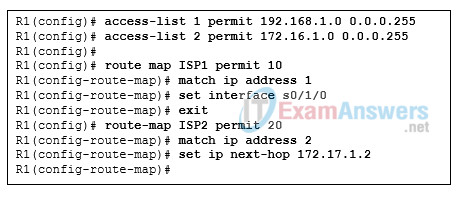 Correct
Correct
Incorrect
Hint
Packets that match access-list 2 will have route-map 20 applied. This route map specifies that matching packets will have a policy applied that sends these packets to the next hop 172.17.1.2. -
Question 4 of 32
4. Question
1 pointsWhich prefix would match the prefix list ip prefix-list NAME seq 5 permit 10.0.0.0/8 ge 22 le 26 ?Correct
Incorrect
Hint
To match the criteria in the prefix list, a prefix must have the same 8 high-order bits as 10.0.0.0/8 and also have a network mask that is equal to or greater than /22 but also less than or equal to /26. The prefix that meets both requirements is 10.0.0.0/24. -
Question 5 of 32
5. Question
1 pointsWhat are two operational characteristics of policy based routing? (Choose two.)Correct
Incorrect
Hint
PBR has the following characteristics and capabilities:- It examines packets as they enter a router interface.
- Local PBR can identify packets that originate from a router.
- It can perform conditional forwarding based on packet characteristics in addition to a source or destination IP address.
- It can forward packets to next-hop addresses that are not in the routing table by using the set ip default next-hop command.
- The next-hop addresses defined in set statements are not placed in the RIB.
-
Question 6 of 32
6. Question
1 pointsRefer to the exhibit. Where would the system administrator apply the following configuration to establish policy-based routing that directs packets from the 10.0.0.0/8 network through the R2 router to the Internet?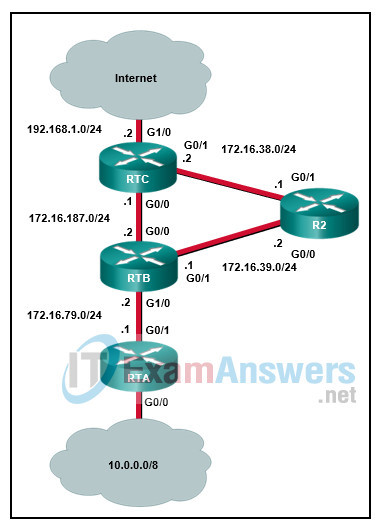
access-list 111 permit ip 10.0.0.0 0.255.255.255 any route-map net-10 permit 10 match ip address 111 set interface gigabitethernet 0/1
Correct
Incorrect
Hint
Route maps are applied to inbound interfaces. Therefore, in this example the route map should be placed on the G1/0 interface of router RTB so that it can forward packets destined for the internet through router R2. -
Question 7 of 32
7. Question
1 pointsWhich rule applies to route map statements?Correct
Incorrect
Hint
Route maps statements have rules as to how they are applied. If no processing action is provided, the default value is permit . If no sequence number is provided, the number increments by 10 automatically. If there is no matching statement, an implied all prefixes statement is applied. Processing of route map statements stops after a match criterion is matched. -
Question 8 of 32
8. Question
1 pointsWhat is the default auto-increment sequence number value of a route map if none is specified?Correct
Incorrect
Hint
If a sequence number is not provided in the route map command, the sequence number is auto-incremented by 10. -
Question 9 of 32
9. Question
1 pointsRefer to the exhibit. Two-way redistribution was configured between OSPF and EIGRP on R2. After the redistribution, R3 does not see any external routes coming from the EIGRP domain. The debug ip ospf database external output reveals that no external LSAs are generated for the routes. What could be the problem?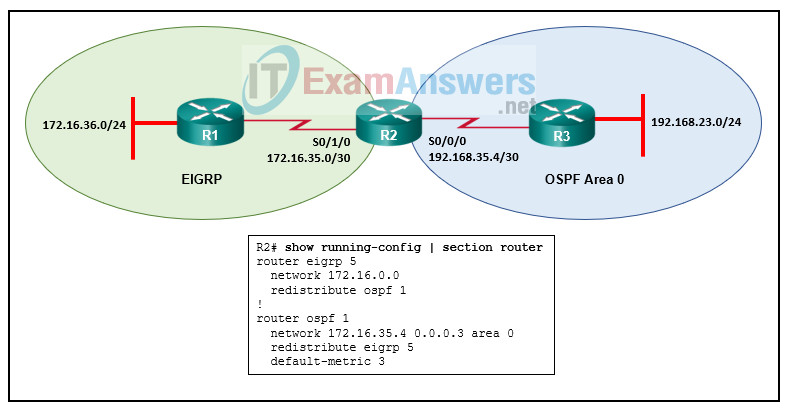 Correct
Correct
Incorrect
Hint
When redistributing into OSPF, if the optional subnets keyword is not included, only classful networks are redistributed. -
Question 10 of 32
10. Question
1 pointsRefer to the exhibit. How will seed metrics be applied to routes redistributed into EIGRP? Correct
Correct
Incorrect
Hint
The default seed metric for routes redistributed into EIGRP is infinity. However, since a seed metric is defined by the default-metric command, this new metric is applied to both RIP and OSPF routes when redistributed into EIGRP. -
Question 11 of 32
11. Question
1 pointsBased on the configuration shown, what code will appear in the routing table for redistributed routes on the router?router ospf 1 router-id 1.1.1.1 network 10.23.1.0 0.0.0.255 area 0 redistribute eigrp 100 subnets metric-type 1
Correct
Incorrect
Hint
The redistribution configuration exists under the destination protocol and identifies the source protocol. The source protocol, EIGRP in this case, provides the network prefixes that are to be redistributed into OSPF. The option for the metric-type keyword is either 1 or 2. Type 2 is the default if not specified. Redistributed routes appear in the routing table with a code of O E1 or OE 2. -
Question 12 of 32
12. Question
1 pointsWhat default weight metric is used by BGP for routes redistributed from an IGP?Correct
Incorrect
Hint
BGP assigns a default weight metric of 32,768 to routes redistributed from IGPs. -
Question 13 of 32
13. Question
1 pointsWhich two statements describe default redistribution behavior? (Choose two.)Correct
Incorrect
Hint
For a route to be redistributed, it must exist in the RIB. Redistribution is sequential but not transitive. By default, BGP redistributes only EBGP routes into IGP protocols. Although EBGP can be redistributed into an IGP, it is not always recommended. -
Question 14 of 32
14. Question
1 pointsRefer to the exhibit. Which three network redistribution actions will take place on router R1? (Choose three.)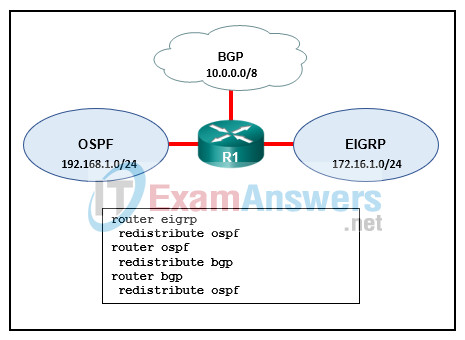 Correct
Correct
Incorrect
Hint
In redistribution between two protocols, the redistribution configuration is issued under the destination protocol and identifies the source protocol. In redistribution between two or more routing protocols on a single router, redistribution is not transitive. -
Question 15 of 32
15. Question
1 pointsRefer to the exhibit. What metric will RIP routes have when redistributed into EIGRP? Correct
Correct
Incorrect
Hint
The default seed metric for EIGRP is infinity. In this example a new seed metric for OSPF routes is defined but not for RIP routes. Therefore, RIP routes will have a metric of infinity when redistributed into EIGRP. -
Question 16 of 32
16. Question
1 pointsWhich two are characteristics of routes redistributed into EIGRP? (Choose two.)Correct
Incorrect
Hint
External EIGRP routes are assigned an administrative distance of 170 and a default seed metric of infinity when they are redistributed into EIGRP. -
Question 17 of 32
17. Question
1 pointsWhich characteristic describes an OSPF type 2 external route?Correct
Incorrect
Hint
There are two types of OSPF external routes, type 1 and type 2. Type 2 is the default setting if not otherwise specified in the redistribute command. The metric for type 1 routes equals the redistribution metric plus the total path metric. For type 2 routes the metric stays the same as the redistribution metric throughout the OSPF domain. The seed metric for BGP-sourced routes redistributed into OSPF is 1. -
Question 18 of 32
18. Question
1 pointsRefer to the exhibit. What redistribution will result from the configuration on R1?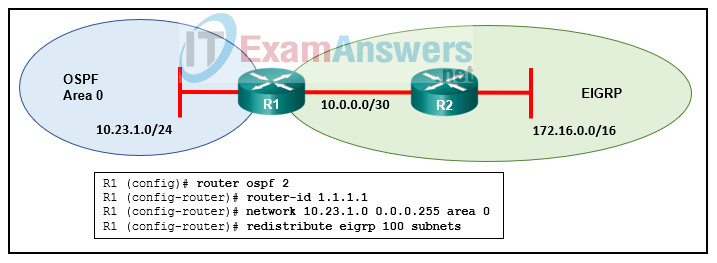 Correct
Correct
Incorrect
Hint
The redistribution configuration exists under the destination protocol and identifies the source protocol. The source protocol, EIGRP in this case, provides the network prefixes that are to be redistributed. Routes redistributed into OSPF from another IGP receive a default seed metric of 20 and a default route type of type 2. -
Question 19 of 32
19. Question
1 pointsWhat two pieces of information are lost when redistributing routes from one routing source into another routing source and injecting a seed metric at the point of redistribution? (Choose two.)Correct
Incorrect
Hint
When routes are being redistributed from one routing source into another routing source, the information from the original routing source is lost when the seed metric is injected at the redistribution point. -
Question 20 of 32
20. Question
1 pointsAfter the implementation of redistribution on a boundary router, a resource connected to a network consisting of varying link speeds is having a delayed response to user connectivity. What issue might exist?Correct
Incorrect
Hint
When implementing mutual redistribution on a network with links using a variety of speeds, it is common for suboptimal routing to occur. -
Question 21 of 32
21. Question
1 pointsRefer to the exhibit. A network engineer has issued the verification command while troubleshooting a routing loop on the network. What is the error in the configuration?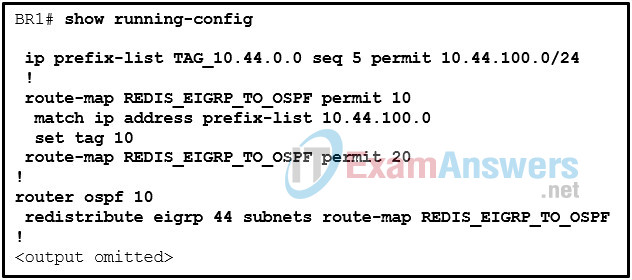 Correct
Correct
Incorrect
Hint
Router BR1 is configured to set a tag of 10 for the routes identified by the prefix list of 10.44.100.0. However, the prefix list being referenced is incorrect and does not exist. -
Question 22 of 32
22. Question
1 pointsWhile configuring a boundary router that utilizes OSPF and BGP, a network engineer performs redistribution without modifying source or destination metrics. What default value is the engineer using for successful redistribution?Correct
Incorrect
Hint
The default seed metric is used by specific routing protocols to provide a default metric value for a destination routing process. This ensures that a metric is available and a route can become reachable after the redistribution process between varying routing protocols. -
Question 23 of 32
23. Question
1 pointsRefer to the exhibit. A network engineer has issued the commands shown on a boundary router. What is the result of this command? Correct
Correct
Incorrect
Hint
The EIGRP configuration command distance eigrp ad-internal ad-external is used to modify the default administrative distance on IOS routers. The valid values for the AD are between 1 and 255; a value of 255 stops the installation of the route into the routing information base (RIB). -
Question 24 of 32
24. Question
1 pointsRefer to the exhibit. A junior administrator issues the show ip protocol command while troubleshooting missing NSSA OSPF routes. What is the most likely cause for the missing OSPF routes?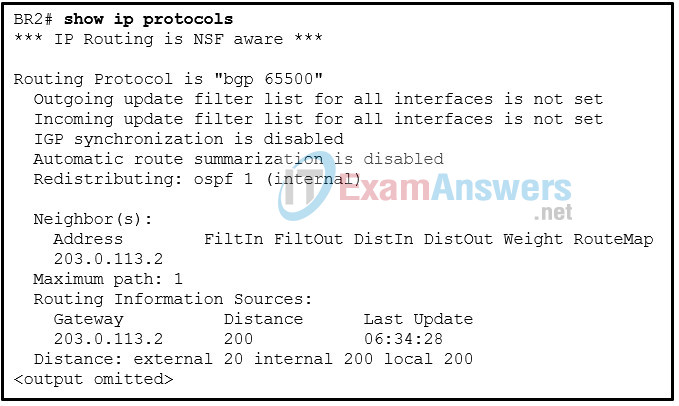 Correct
Correct
Incorrect
Hint
The redistribution process does not include external OSPF routes by default. In order to allow the external OSPF routes to be implemented with redistribution, the match keyword should be used. -
Question 25 of 32
25. Question
1 pointsA network engineer has issued the following configuration commands:router ospf 1 router-id 200.200.200.200 distance ospf intra-area 101 inter-area 104 external 122 network 10.44.11.0 0.0.0.255 area 0 redistribute eigrp 100 metric-type 1
What outcome is expected from the commands issued?Correct
Incorrect
Hint
The subnets keyword is extremely important in the redistribution of routes into the OSPF routing process. Without the subnets keyword, only classful networks will be included in the redistribution process. -
Question 26 of 32
26. Question
1 pointsA boundary router is performing mutual redistribution between OSPF and EIGRP. What process should be taken to have an external EIGRP route preferred over an OSPF route to the same destination network?Correct
Incorrect
Hint
In order to have an external EIGRP route with a default AD of 170 preferred over an OSPF route with a default AD of 110 to the same destination network, the administrative distance value should be modified to a lower value. -
Question 27 of 32
27. Question
1 pointsAn IPv6 network topology using redistribution is experiencing reachability issues after migrating from an IPv4 deployment. How is the deployment of IPv6 redistribution different from what it is with IPv4?Correct
Incorrect
Hint
In order to include the networks associated with the local interfaces participating in the routing process that is being redistributed, the include-connected keyword must be used. -
Question 28 of 32
28. Question
1 pointsIf multiple seed metrics are defined with redistribution, which metric would be preferred over others?Correct
Incorrect
Hint
When working with dissimilar routing protocols, a network technician must remember that a seed metric has the following order of preference:- A metric defined in the route map that was applied to the redistribute command
- A metric parameter defined with the redistribute command
- A metric defined with the default-metric command
-
Question 29 of 32
29. Question
1 pointsWhich two statements describe default behaviors of route redistribution? (Choose two.)Correct
Incorrect
Hint
Default redistribution behavior is as follows:- BGP only redistributes EBGP routes into IGP protocols.
- Routes redistributed into OSPF from BGP have a seed metric of 1.
- Routes redistributed into EIGRP have an AD of 170.
- Routes redistributed into OSPF have an AD of 110.
- The default BGP weight for redistributed routes is 32,768.
-
Question 30 of 32
30. Question
1 pointsWhat is the default OSPF seed metric for routes redistributed from BGP?Correct
Incorrect
Hint
Routes learned through another routing protocol are treated as external routes by OSPF. Routes learned from BGP are given a default seed metric of 1. Routes learned from another IGP are given a default seed metric of 20. -
Question 31 of 32
31. Question
1 pointsA network engineer has issued the show run | section router eigrp command. What outcome is expected from the command output?R1# show run | section router eigrp router eigrp 99 network 172.21.33.1 0.0.0.0 redistribute ospf 1 ipv6 router eigrp 99 redistribute ospf 1 metric 100000 100 255 1 1500 include-connected
Correct
Incorrect
Hint
The metric keyword is required when redistributing OSPF routes into an EIGRP routing process. -
Question 32 of 32
32. Question
1 pointsA network engineer has issued the following configuration commands:router ospf 10 router-id 10.10.10.10 distance ospf intra-area 105 inter-area 107 external 144 network 10.44.11.0 0.0.0.255 area 0 router bgp 65001 address-family ipv6 unicast redistribute ospf 10
What outcome is expected from the commands issued?Correct
Incorrect
Hint
When OSPF is being redistributed into BGP, the match keyword must be included during redistribution in order to include external OSPF routes. Without the match keyword, only internal OSPF routes are included in the redistribution process.
